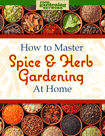
There’s something grounding about snipping herbs straight from your garden instead of tearing open a plastic package. Nurturing tiny seeds into vibrant greens that flavor your next meal feels almost magical.
However, herbs are for far more than cooking. Many offer medicinal properties to ease everyday ailments, while others fill your kitchen with uplifting, aromatic scents. Are you ready to explore the dual life of these healing plants?
Find out how easy growing spices and herbs can be—indoors or out! Read our FREEBIE How to Master Spice and Herb Gardening at Home right now!
Why Grow Dual-Purpose Herbs?
Dual-purpose herbs are a gardener’s dream. They offer a sustainable alternative to grocery options by drastically reducing food miles. While many fruits and vegetables contribute to significant transportation emissions, homegrown herbs are as close to farm-to-kitchen as they get. If you don’t have the yard space or energy to maintain a garden, try growing herbs in small containers on your windowsill.
You may cultivate herbs primarily for zesting up your favorite recipes, but their powers stretch beyond the spice rack. They’re perfect for busy people, since you don’t need a sprawling homestead to enjoy their benefits. A pot overflowing with a thriving plant can enliven a sunny porch or balcony.
These edible herbs pull double duty as emotional support plants for your well-being. Snip them when you feel anxious or have an upset stomach.
Top 10 Dual-Purpose Herbs for Every Garden
Grow flavors and antidotes in a pot with these top 10 medicinal plants and their uses.
1. Cilantro and Coriander
For those unaware, cilantro and coriander come from the same plant — Coriandrum sativum — but refer to different parts. Cilantro is the fresh green foliage that gives foods like tacos and banh mi their signature zest. When the plant bolts and sends up flower stalks, it produces earthy, citrusy and subtly sweet coriander seeds, often found in curries or spice rubs on meat.
Most notably, coriander seeds can naturally lower blood sugar, so much so that health care providers frequently advise their patients who take diabetes medications to limit their intake.
2. Lemongrass
You might overlook a lemongrass plant if you see one growing wild, as it resembles tall grass. However, this herb is a renowned Southeast Asian flavoring that makes a calming aromatic tea. Lemongrass contains citral, a compound with antibacterial, antifungal and anti-inflammatory properties. It also works as a natural mosquito repellent and stress reliever.
3. Lavender
Many people swear by lavender room sprays and teas to promote relaxation and better sleep. Lavender contains linalool, a natural compound that reduces anxiety and stress. Beyond its soothing aroma, lavender is also perfect for infusing cakes, cookies and even ice cream with a subtle floral flavor. My personal favorite: lavender lemonade!
4. Thyme
Thyme might be your go-to seasoning for meat rubs and hearty stocks, but it could also be the remedy you reach for when a cough starts brewing. It loosens mucus and relaxes the airways to ease persistent coughing.
5. Oregano
Like thyme, oregano contains carvacrol and thymol — antioxidants that give it antimicrobial and antibacterial properties. It reduces inflammation and may alleviate symptoms linked to chronic diseases.
6. Rosemary
Rosemary has a fresh, pine-like aroma that pairs beautifully with lamb, chicken and pork. It also supports digestive comfort, perfect for when you’ve overindulged at the table. Thanks to compounds like carnosic and rosmarinic acid, rosemary has anti-inflammatory properties that can ease muscle aches. However, use the essential oil version carefully, as it can be toxic in large amounts.
7. Mint
Mint is a culinary crowd-pleaser, perfect for whipping up a batch of brunch mojitos or a soothing pot of afternoon tea. Beyond its refreshing flavor, mint eases indigestion and headaches. Peppermint, in particular, relieves gas and bloating by relaxing stomach muscles. Additionally, the menthol in mint eases menstrual cramps’ severity and duration.
8. Basil
Tomato-basil is a classic pizza pairing, or maybe you prefer to blend your basil with pine nuts, Parmesan and a generous splash of olive oil for homemade pesto. However, you enjoy this flavorful herb, its nickname is “great basil” for a reason — its benefits seem endless. Basil may lower blood pressure and decrease cholesterol, turning a hearty meal into one that’s heart-healthy, too.
9. Lemon Balm
Lemon balm adds a refreshing lemony twist to desserts and salads, especially if churned into ice cream and drizzled with raspberry coulis. Aside from that, it may improve memory and cognition in people with Alzheimer’s. Lemon balm could even be the solution you’re looking for if your loved ones grind their teeth while they sleep.
10. Parsley
Many dishes feel incomplete without a sprinkle of parsley on top. This popular garnish shines in compound butters and savory stuffing.
Benefit-wise, parsley is rich in vitamin C and carotenoids — the same pigments that give carrots their bright orange hue. Given its nutritional overlap, it’s a wonder the herb isn’t orange. Additionally, parsley is a natural diuretic, helping flush out excess water and reduce bloating.
How to Create Your Herb Garden
You don’t need a backyard to enjoy herbs for health and kitchen creations. Here are a few simple steps to get started.
- Location, location, location: Many of these plants flourish in indoor herb gardens if they are in a south-facing window that gets at least six to eight hours of sunlight daily.
- Right pots, right soil: Use containers with drainage holes and nutrient-rich potting mix. Add fertilizer to ensure your herbs get their essential nutrients. Diluting a tablespoon of Epsom salt into a gallon of water gives plants an extra kick of magnesium.
- Water wisely: Don’t overwater. Many herbs prefer slightly dry conditions. If you grow them indoors, that’s all the more reason to water less frequently, as they’ll receive less direct sun than outdoor plants.
- Prune regularly: Don’t be afraid to snip your herbs frequently. Harvesting promotes new growth and prevents legginess. You want full, bushy plants, not sparse and spindly stems.
- Rotate plants: Plants can grow unevenly and become lopsided if they only get light from one direction. Rotate your pots weekly to ensure all sides receive equal sunlight and maintain balanced growth.
Your Kitchen Apothecary Starts Here
A few pots on your windowsill can help you start growing herbs indoors for a personal wellness toolkit. Far more than seasonings, these dual-purpose plants are herbs for health, soothing and adding charming greenery to your home.
Grow them with intention and harvest with gratitude, knowing they’re doing double the work.
Find out how easy growing spices and herbs can be—indoors or out! Read our FREEBIE How to Master Spice and Herb Gardening at Home right now!




